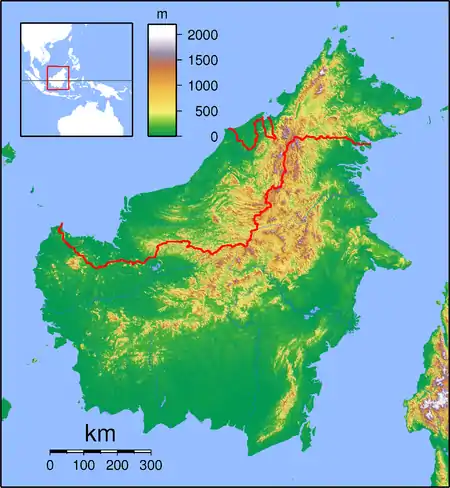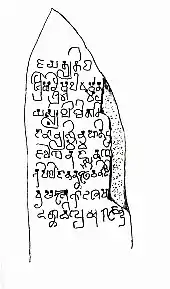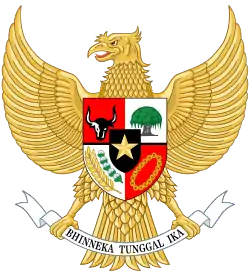Kutai
Kutai is a historical region in East Kalimantan, Indonesia on the island of Borneo and is also the name of the native ethnic of the region, numbering around 300,000 who have their own language of the same name and their own rich history. Today the name is preserved in the names of three regencies in East Kalimantan, the Kutai Kartanegara Regency, the West Kutai Regency and the East Kutai Regency. The major river of the region is the Mahakam River.

History
The history is usually divided into two periods, that of the early Kutai Martadipura phase some time beginning from 350–400 and the later Kutai Kartanegara phase beginning around 1300. The first period produced the earliest known inscriptions in Indonesia.
Kutai Martadipura


Kutai Martadipura is a 4th-century or perhaps much earlier Hindu kingdom located in the Kutai area, East Kalimantan.[1]:52 It is one of the earliest ancient kingdom in Indonesian history. Seven stone pillars, or yūpa (“sacrificial posts”), have been found in Kutai, Kaman Estuary, near the Mahakam River.[2] The plinths bear an inscription in the Pallava script of India reading "A gift to the Brahmin priests". The style of the script has been dated to the last half the 4th century.[3] It is believed these religions were brought to Indonesia around the 2nd and 4th centuries, respectively, when Indian traders arrived on the islands of Sumatra, Java and Sulawesi.[4]
The names of three rulers are known from the inscriptions. The first ruler mentioned is Kuḍungga, the “lord of men” (narendra), his son Aśwawarman, styled the “founder of the dynasty” (vaṇśa-kartṛ) and grandson of the first and son of the later, Mulavarman called the “lord of kings” (rājendra). As Kuṇḍungga does not seem to be a name of Sanskrit hinduistic style while the other two are, it is presumed he was a leader of local origin ( Dayak People ) and it was his son Aśwawarman that adopted the hinduistic belief.[3] It was Mūlawarman who let these inscriptions be made. While nothing of the military actions of his two predecessors is known, "Raja" Mūlawarman is stated to have conquered his neighbours in battle. He is also said to have increased the land of Kutai by a local ritual called "Asvaredjwa". This ritual required a horse released to his land. The footsteps of the freely roaming horse were taken as evidence that this land belonged to Kutai. Mulawarman was also known for his tribute of gold to his God. The name of his kingdom is not mentioned on the inscriptions nor do any other documents in other countries relate to a kingdom at this time in this region. It is not known what became of the kingdom after these pillars had been erected. It may be possible that the name Kutai, as in Tuñjung Kute of the 1365 Javanese Majapahit poem Nāgarakṛtāgama is as ancient and reflects the original name used a thousand years earlier.
Part of a series on the |
|---|
| History of Indonesia |
   |
| Timeline |
|
|
Kutai Kartanegara Sultanate

Around the end of the 13th century the kingdom of Kutai Kartanegara was established in the region of Tepian Batu or Kutai Lama. The first known ruler is Aji Batara Agung Dewa Sakti, who is thought to have ruled from 1300 to 1325.[2] Aji Pangeran Sinum Panji Mendapa, who ruled 1635–1650, was able to conquer the kingdom of Kutai Martadipura and merged the two realms thus Kutai Kartanegara Ing Martadipura.[2]
In 1667 the Dutch V.O.C. attacked Makassar on the island of Sulawesi leading to the downfall of the Bugis Kingdom of Gowa. Some of the Bugis under the leadership of Lamohang Daeng Mangkona or Pua Ado I immigrated to Kutai on neighbouring Borneo (Kalimantan) and the ruler of Kutai allowed them to settle in Kampung Melantai around the Karang Mumus River, now known as Kampung Selili. This settlement eventually developed into the modern town of Samarinda.
Islam took hold in the region since the 17th century (most of the Bugis were Muslims) and Aji Muhammad Idris, ruling 1732–1739?, was the first ruler to have an Islamic name.
After a civil war Aji Imbut, after finally becoming the ruler as Aji Muhammad Muslihuddin in 1780, moved the capital in 1782 from Pemarangan to Tepian Pandan.[2] The name of the capital city eventually developed from Tangga Arung to its present form of Tenggarong.
In 1844, following the repulse of James Erskine Murray's expedition and attempt to settle,[5] the Dutch defeated the Sultan Aji Muhammad Salehudin, forcing him into exile, and took direct control of Kutai.
The Japanese invaded the region in 1942 and acknowledged a "Kooti Kingdom", that was a subject of the Tenno. In 1945 Kutai joined, along with its neighbours, into the East Kalimantan federation.
In 1949 Kutai finally became part of the Republic of Indonesia.
The Kutai Language
The traditional language of the region is referred to as Tanggarong Kutai and is considered a variety of Malay,[6][7] such as Banjarese to the south, Kota Bangun Kutainese to the west, Berau to the north and others more distant.[8] As such Tanggarong Kutai belongs to the large Austronesian family of languages.
See also
References
- Coedès, George (1968). Walter F. Vella (ed.). The Indianized States of Southeast Asia. trans.Susan Brown Cowing. University of Hawaii Press. ISBN 978-0-8248-0368-1.
- Kutai Kingdom Archived 3 March 2016 at the Wayback Machine on Melayu Online
- "The Earliest Indic State: Kutai". Archived from the original on 25 December 2013. Retrieved 18 July 2008.
- "The Period of Hindu Kingdoms". Embassy of Republic of Indonesia at Bangkok, Thailand. 2006. Archived from the original on 7 November 2006. Retrieved 17 October 2006.
- Iem Brown. The Territories of Indonesia (2004).
- Ethnologue report for Local Malay
- The Tenggarong Kutai in the Joshua Project
- Language Map on www.ethnologue.com
- Kutai Martadipura
- Vogel, J.Ph. 1918 The yūpa inscriptions of King Mūlavarman from Koetei (East Borneo). Bijdragen tot de Taal-, Land- en Volkenkunde 74:216–218.
- Chhabra, B.Ch. 1965 Expansion of Indo-Aryan culture during Pallava rule (as evidenced by inscriptions). Delhi: Munshi Ram Manohar Lal. 50–52, 85–92;
- Casparis, J.G. de 1975 Indonesian palaeography: a history of writing in Indonesia from the beginning to c. A.D. 1500. Leiden: E.J. Brill. 14–18
External links
- The Museum of Mulawarman
- Description of the Erau, a traditional yearly Kutai culture festival.